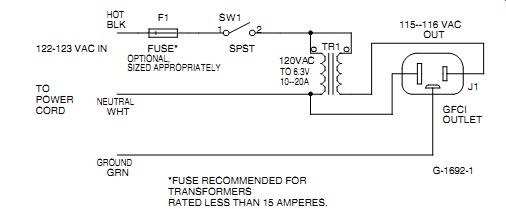Taming High Line Voltage
During my efforts to restore an old Harman Kardon stereo amplifier and a couple of old H.H. Scott mono integrated amps, I noticed that all of my voltage measurements were consistently 5-10% higher than in my schematics. This was a concern to me because those old power-sup ply capacitors are under plenty of stress.
After a quick bit of detective work, I identified my home's line voltage as the culprit.
I monitored my line voltage for a week and discovered that it consistently ran at 121-123V AC. This is significantly higher (about 5%) than the 115-117V AC line volt ages common in the 1950s. So I was determined to find a way to lower the line voltage supplied to my amps. (All of my schematics indicate that the measurements were taken with a line voltage of 117V AC.)
WIRING SOLUTION
My first thought was to use an auto-transformer to drop the 123V AC to 117V AC; however, these are heavy, hard to find, and expensive. A Variac is an alternative, but I certainly wasn't going to dedicate one to this application. The approach that I came up with is simple, elegant, less expensive, and much lighter.
My solution was to wire the output of a 6.3V AC 20A filament transformer in series with the line voltage, making certain that it was in reverse phase with the line voltage (Fig. 1). By wiring the transformer output in series and reverse phase, the line voltage is reduced by an amount equal to the filament transformer voltage.
Select the filament transformer output voltage and current rating to suit your needs. The primary winding of the filament transformer does not need to be rated for the full current load, just the secondary. (This cuts down the weight.) My transformer had a center tap so I could have used it to drop the voltage by 3.5V AC instead.
I added a line cord, a switch, and a GFCI receptacle to a small electrical breaker box to complete the project. The end result is a 6-7V AC reduction in the line voltage. My vintage amplifiers are now supplied with 115-116V AC, and I am sleeping much better.
CAUTIONS
The transformer should be of good quality and must be overrated for the application so that it doesn't become hot. All of the components in my voltage conditioner are rated for 20A with the exception of the line cord, which is rated for 13A. Although I don't expect to ever pull more than 10A from the supply, I will be replacing the cord with a 15A one.
Watch out for transformers that hum.
My transformer has a very low hum that is barely audible. Encasing it in the heavy steel breaker box has virtually eliminated all traces of the noise.
The switch and the fuse or circuit breaker are optional; however, I recommend that you use a fuse if your filament transformer is rated for less than 15A since you can't expect your home's 15A circuit breaker to protect it. You could also add electrical noise filters and a neon lamp wired to the GFCI receptacle.
I think the GFCI receptacle is essential even though all of my old amps have only two-wire plugs. It is a good idea to replace those old unpolarized two-wire cords with modern two-wire polarized cords. If necessary, rewire the amp's switch, fuse, and transformer so that there are no breaks in the neutral conductor. I like to put the fuse in the circuit first, ahead of the switch.
Michael Sciascia
Livingston, N.J.

FIGURE 1: Line voltage conditioner.
Also see: